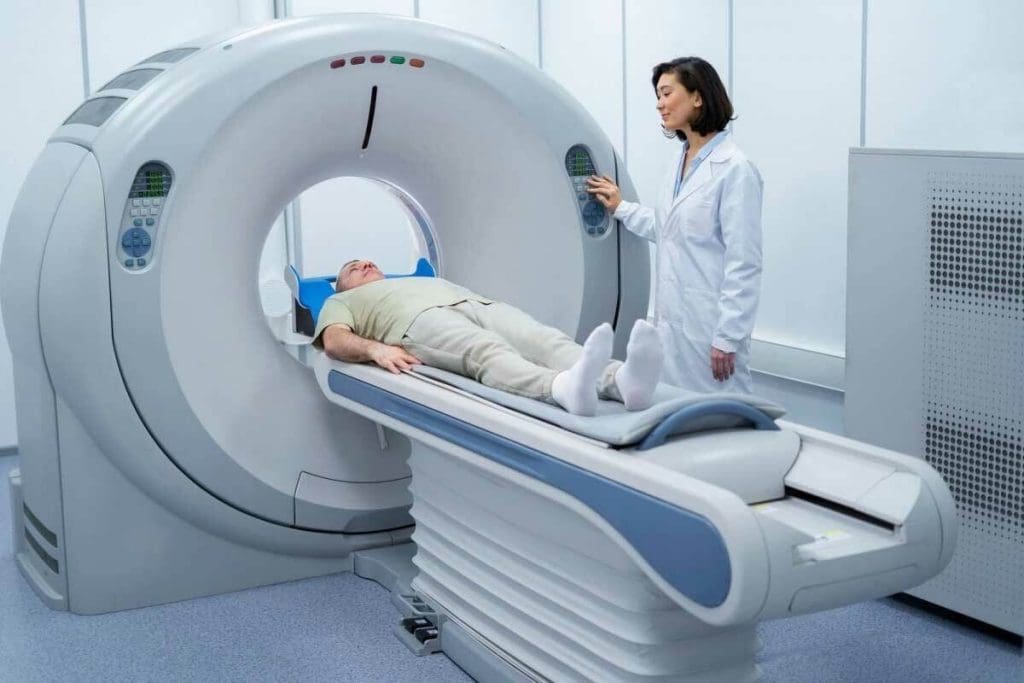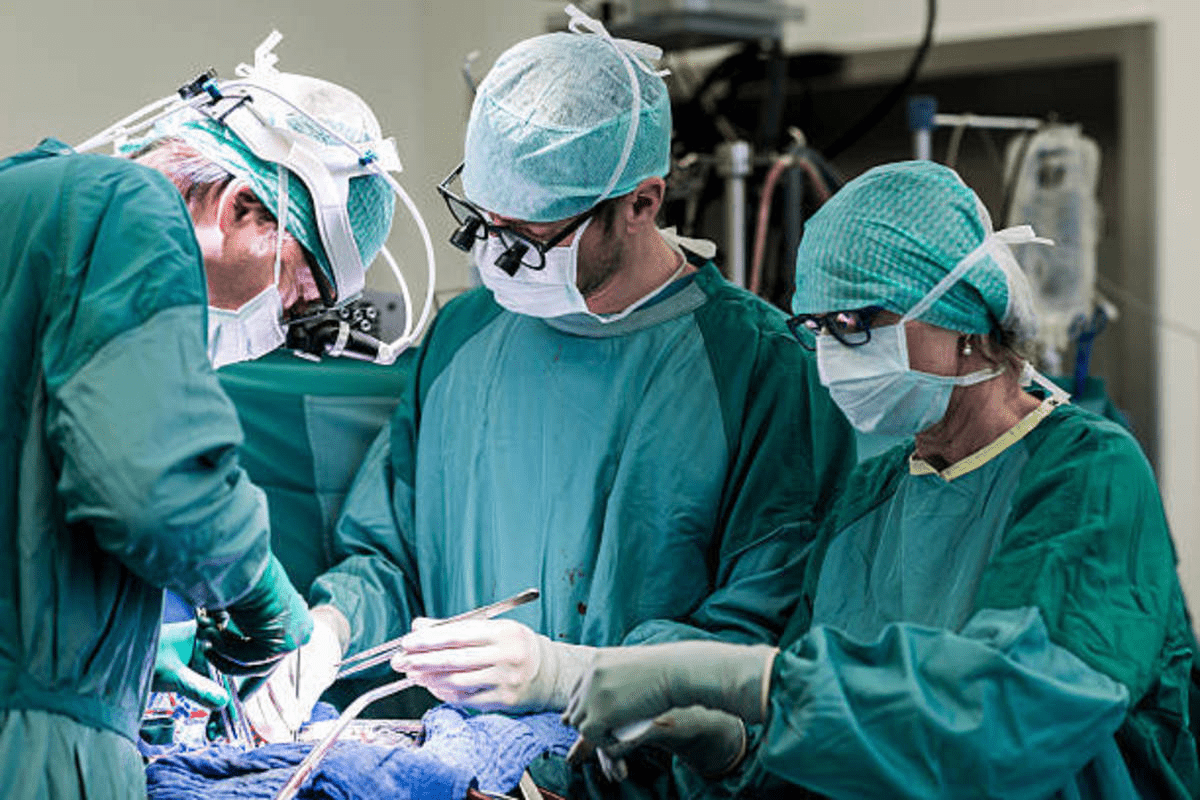Last Updated on November 27, 2025 by Bilal Hasdemir

When you get a CT scan, having metal in your body can change things. This could be from implants or dental fillings. A CT scanner uses X-rays to make detailed pictures of what’s inside you.
The metal in your body can mess with the X-rays, which is a common issue when it comes to CAT scan and metal interference. This might make your pictures blurry with streaks or shadows. The skilled professionals at Liv Hospital utilize cutting-edge technology and techniques to ensure that your scan is both precise and clear.
Key Takeaways
- Metal in the body can cause artifacts during a CT scan.
- Advanced imaging technology can help minimize these artifacts.
- Liv Hospital uses the latest protocols for diagnostic accuracy.
- CT scans provide detailed images of internal body structures.
- Our team is trained to handle cases with metal implants or fillings.
Understanding CT Scans and Their Importance

CT scans are key in modern medicine. They give vital info for diagnosing and planning treatments. These scans show detailed images of the body’s inside, helping doctors spot and manage many health issues.
Basic Principles of CT Imaging
CT imaging uses X-rays to see inside the body. It works by moving an X-ray source and detectors around the patient. This captures data from many angles, making detailed images.
Over time, CT scans have gotten better. Now, with multidetector CT (MDCT), scans are faster and clearer. This helps doctors find problems sooner and more accurately.
Diagnostic Value of CT Scans
CT scans are great for showing what’s inside the body. They’re good for spotting injuries, cancers, and blood vessel problems. For example, they can find bleeding, breaks, and tumors that X-rays can’t.
- Rapid diagnosis in emergency situations
- Detailed imaging of complex anatomical structures
- Guiding minimally invasive procedures
- Monitoring disease progression and treatment response
For more info on CT scan artifacts, check out this resource.
Overview of Metal Concerns
CT scans are very useful, but metal in the body can make them tricky. Metal artifacts, like streaks or shadows, can happen. These can hide important details or make images hard to understand.
It’s important to know about metal in CT scans, mainly for those with metal implants. We’ll dive deeper into metal artifacts and how they affect image quality.
The Science Behind Cat Scan and Metal Interactions

It’s important to know how metal affects CT scans for accurate diagnoses. Metal in the body can change the quality of CT images.
X-ray Attenuation Properties
Metals absorb a lot of X-rays, which can distort CT images. This makes it hard to read the scans correctly. Experts say metal can hide important details in the body.
Different metals affect CT scans in different ways. For example, metals like stainless steel and cobalt cause more problems than metals like titanium and aluminum.
How Metal Density Affects Imaging
The density of metal implants affects how they interact with X-rays. Denser metals absorb more X-rays, leading to artifacts. These artifacts can hide important details in the body.
Knowing the type and density of metal is key to understanding its impact on CT scans. This helps doctors make better diagnoses.
Physical Principles of Metal-Beam Interaction
The way X-rays interact with metal implants follows certain physical rules. The metal’s atomic number, density, and the X-ray beam’s energy all play a part.
A leading radiology journal notes that metal artifacts depend on the metal’s properties and the CT scanner’s quality. This shows how complex metal interactions are and why we need advanced imaging.
By grasping the science behind CT scans and metal interactions, we can improve patient care. This is true for patients with metal implants.
Types of Metal Artifacts in CT Imaging
Metal artifacts are a common problem in CT imaging. They can hide important details needed for diagnosis. Knowing about these artifacts helps doctors give better care.
Beam Hardening Phenomena
Beam hardening happens when X-rays pass through dense materials like metal. This makes areas near the metal appear darker. Beam hardening artifacts are a big issue when scanning areas with metal implants.
Photon Starvation Effects
Photon starvation occurs when there aren’t enough X-rays to measure through metal. This leads to streaking artifacts or dark bands. It’s more common with very dense metals.
Streaking and Shadowing Artifacts
Streaking and shadowing artifacts are common with metal in CT scans. Streaking shows as bright or dark lines from the metal. Shadowing creates dark areas next to the metal. These can make images hard to read. New CT scanners and software help reduce these issues.
Some common types of metal artifacts include:
- Beam hardening artifacts
- Photon starvation artifacts
- Streaking artifacts
- Shadowing artifacts
Understanding metal artifacts in CT imaging is key. New technologies and methods are improving image quality. This helps doctors make better diagnoses.
How Different Metals Affect CT Scan Results
The impact of metal on CT scan images changes based on the metal’s properties. Different metals can cause various levels of artifacts. These are distortions in the image that can hide important details.
High Atomic Number Metals (Stainless Steel, Cobalt)
Metals with high atomic numbers, like stainless steel and cobalt, create more artifacts in CT scans. These metals are dense and block or weaken X-rays. This leads to streaks or shadows in the images.
For example, patients with stainless steel implants might see more artifacts than those with other materials.
Lower Atomic Number Metals (Titanium, Aluminum)
On the other hand, metals with lower atomic numbers, such as titanium and aluminum, cause fewer artifacts. Titanium is often used in implants because it’s safe and doesn’t distort CT images much. This makes titanium implants better for patients needing frequent scans.
Dental Materials and Their Effects
Dental materials, like fillings, crowns, and implants, can also affect CT scan quality. Metals in dental work, such as amalgam, gold, or silver, can cause artifacts. The severity of these artifacts depends on the metal type and its location.
Comparison of Artifact Severity by Metal Type
Comparing the severity of artifacts from different metals shows that atomic number and density matter. Higher atomic number metals usually cause more severe artifacts. Knowing this helps radiologists and clinicians make better decisions.
We know that metal in the body can make CT scans harder to read. But by understanding how metals affect imaging, healthcare providers can improve diagnosis accuracy.
Common Medical Implants and Their CT Scan Compatibility
When you get a CT scan, knowing how medical implants work with the technology is key. Different implants can change how well a CT scan works. This depends a lot on the type of implant and what it’s made of.
Orthopedic Hardware
Orthopedic hardware, like joint replacements and screws, helps fix bones and joints. These are usually made from metals like titanium or stainless steel. These metals can make artifacts on CT scans because of their density and atomic number.
The metal used in these implants matters a lot. For example, titanium might cause fewer artifacts than stainless steel because it has a lower atomic number.
Dental Work
Dental work, like fillings and implants, can also affect CT scans. The materials used in dental work vary, and some contain metals that can cause artifacts, mainly in the jaw and face.
The type of dental material used affects how much of an artifact it causes. For instance, amalgam fillings can cause more artifacts than ceramic or composite resin fillings.
Cardiac Devices
Cardiac devices, like pacemakers and stents, help manage heart conditions. These are made to work well with imaging technologies, including CT scans.
Even so, these devices can cause artifacts. It’s very important to tell your healthcare team about these implants before a CT scan. Modern CT scanners and techniques help reduce artifacts from these devices.
Neurological Implants and Other Medical Devices
Neurological implants, such as deep brain stimulators, are used for neurological conditions. These can cause artifacts on CT scans, and their compatibility needs to be checked carefully.
Other devices, like surgical clips and implantable ports, can also impact CT scan results. Knowing the details of these devices and their materials is key for accurate CT scan interpretation.
| Implant Type | Material | Artifact Severity |
| Orthopedic Hardware | Titanium/Stainless Steel | Moderate to Severe |
| Dental Fillings | Amalgam/Composite | Mild to Moderate |
| Cardiac Devices | Titanium/Platinum | Mild |
| Neurological Implants | Titanium/Stainless Steel | Moderate |
Understanding how medical implants work with CT scans helps healthcare providers make better diagnoses. It’s very important for patients with implants to tell their healthcare team about them before a CT scan.
Modern Metal Artifact Reduction Technologies
Modern CT scanners use new ways to lessen metal artifacts’ impact on image quality. These updates have greatly boosted the CT scan’s value for patients with metal implants.
MAR Algorithms and Software Solutions
Metal Artifact Reduction (MAR) algorithms are advanced software tools. They aim to lessen metal’s effects on CT images. These algorithms spot metal areas, fill in missing data, and create images without metal artifacts.
Many MAR algorithms exist, each with its own benefits and drawbacks. Some top MAR techniques include:
- Orthopedic metal artifact reduction
- Gemstone spectral imaging
- Smart MAR
Metal Deletion Technique
The Metal Deletion Technique (MDT) is another method to cut down metal artifacts in CT images. It removes metal from the image, replacing it with a substitute, and then rebuilds the image.
MDT works well for big metal objects, like hip prostheses. But, it needs careful settings to avoid new artifacts.
Dual-Energy CT Applications
Dual-Energy CT (DECT) captures CT data at two energy levels at once. This tech helps reduce metal artifacts by giving more info on the object’s material.
DECT helps tell apart different materials, like metal and bone. It also makes virtual monoenergetic images, cutting down beam hardening artifacts.
Iterative Reconstruction Methods
Iterative reconstruction (IR) methods are advanced techniques to enhance image quality and cut down artifacts. IR algorithms refine the image estimate until it reaches a stable state.
IR is great for reducing noise and artifacts in low-dose CT scans. When paired with MAR algorithms, IR boosts image quality in patients with metal implants.
| Technology | Description | Benefits |
| MAR Algorithms | Software solutions to reduce metal artifacts | Improved image quality, reduced artifacts |
| Metal Deletion Technique | Segments and replaces metal with surrogate material | Effective for large metal objects |
| Dual-Energy CT | Simultaneous acquisition at two energy levels | Material differentiation, reduced beam hardening |
| Iterative Reconstruction | Advanced image reconstruction technique | Improved image quality, reduced noise and artifacts |
By using these technologies together, modern CT scanners can greatly lessen metal artifacts. This improves diagnostic accuracy for patients with metal implants.
Patient Preparation for CT Scans with Metal Implants
Getting ready for a CT scan with metal implants is key for clear images. As a patient, knowing how to prepare is important. It helps make the scanning process smooth and safe.
Removable vs. Non-removable Metal Items
Take off any metal items like jewelry or glasses before your scan. But, some implants like pacemakers can’t be removed. Tell your doctor about any metal implants or objects you have.
Informing Your Healthcare Provider
Tell your doctor about any metal implants or objects in your body. This helps us plan your CT scan safely. Share details about any surgeries or implants you’ve had.
Documentation Requirements for Implants
Bring any papers about your metal implants, like medical records. This helps us understand your implants better. We can then adjust the scan as needed.
Positioning Considerations
How you sit on the CT scan table is very important. Our team will help you get into the right spot. They’ll make sure you’re comfortable during the scan.
By following these steps and talking with your doctor, we can reduce metal artifacts. This way, we get clear CT images. These images help doctors make accurate diagnoses and plans for treatment.
Safety Considerations and Misconceptions
It’s important to know the risks and myths about CT scans with metal implants. CT scans are very useful, but metal in the body can cause worries.
Is There Any Risk to Metal Implants During CT?
CT scans are usually safe for people with metal implants. But, there are some risks to think about. The X-rays in CT scans might heat up or move metal implants, but this is rare.
Most implants today work well with CT scans. But, it’s key to tell your doctor about any metal implants or devices you have.
Radiation Considerations Near Metal
Metal can make CT scan images less clear because of artifacts. But, the radiation itself is not a big risk to metal implants. Radiation exposure is more about the patient’s overall health, like long-term risks.
Even so, the benefits of a CT scan usually outweigh the risks. This is true when other imaging methods don’t work well.
Common Misconceptions About Metal in CT Scans
Many think all metal implants cause big problems with CT scans. But, modern CT scanners and algorithms help reduce these issues. Another myth is that CT scans are not safe for certain metal implants.
In reality, most patients with metal implants can safely get CT scans with the right precautions.
When Alternative Imaging May Be Recommended
In some cases, MRI or ultrasound might be better than CT scans. This is true if metal implants could cause big problems or if CT scans aren’t the best choice. The right imaging depends on the metal implant, the patient’s health, and what the doctor needs to see.
| Imaging Modality | Suitability for Metal Implants | Common Uses |
| CT Scan | Generally suitable, with some precautions | Diagnostic imaging for various conditions, specially when metal implants are present |
| MRI | May be contraindicated for certain metal implants | Soft tissue imaging, neurological, and musculoskeletal conditions |
| Ultrasound | Usually safe, regardless of metal implants | Imaging of superficial structures, guiding interventions |
How Radiologists Handle Metal Artifacts
Radiologists use special techniques to deal with metal artifacts in CT scans. These artifacts can hide important details. We’ll look at how they handle these challenges.
Specialized Reading Techniques
Radiologists adjust settings and use advanced algorithms to reduce metal artifacts. This helps us see structures near metal implants better. It’s all about improving image quality.
Image manipulation is key. It lets radiologists make better diagnoses. Tools like metal artifact reduction (MAR) algorithms are very helpful.
Working Around Artifacts to Make Diagnoses
At times, radiologists must find ways to diagnose despite artifacts. They analyze images carefully and use their experience to guess what’s hidden. They might also compare images from previous scans.
With their skills and experience, radiologists can usually make accurate diagnoses. It’s important to communicate well with doctors who ordered the scan.
When Additional Imaging May Be Needed
Even with the best efforts, metal artifacts can sometimes limit what a CT scan can show. In these cases, we might suggest additional imaging modalities like MRI or ultrasound. This choice depends on the patient’s situation and what we need to know.
Communication Between Radiologists and Referring Physicians
Good communication between radiologists and doctors is vital when dealing with metal artifacts. We work with them to make sure they understand the scan’s limitations. This teamwork helps ensure patients get the best care for their needs.
By using our knowledge and working together, we can improve patient outcomes, even with metal artifacts.
Conclusion: Advances in CT Technology for Patients with Metal Implants
CT technology has made big strides in helping diagnose patients with metal implants. At Liv Hospital, we use the latest research and imaging tech to help our patients. This means we can handle the issues that come up when metal is in the body during a CT scan.
Thanks to new tech like Dual Energy CT (DECT) and Metal Artifact Reduction (MAR) algorithms, we can get clearer images. For more details, check out the National Center for Biotechnology Information website.
These advancements help us give more accurate diagnoses and better treatment plans. Our goal is to use the best CT scan tech to ensure top care for patients, even with metal in the scanner.
FAQ
What happens if I wear metal during a CT scan?
Wearing metal during a CT scan can cause image distortions. These distortions can make it hard to understand the image. We suggest removing any metal items before the scan.
Can I have metal in my body during a CT scan?
Yes, many people have metal implants. Our technology and techniques help reduce issues during the scan.
How does metal affect CT scan results?
Metal can lead to image distortions. These distortions depend on the metal type, density, and location.
What are the risks to my metal implant during a CT scan?
CT scans are usually safe for metal implants. But, there’s a small risk of implant heating or movement. We take steps to keep you safe.
Do I need to remove my dental work for a CT scan?
It depends on the scan type and metal location. We might ask you to remove certain dental items.
How do radiologists handle metal artifacts in CT scans?
Our radiologists know how to handle metal artifacts. They use special techniques and technology to improve scan quality.
Can I undergo a CT scan with a pacemaker or other cardiac device?
Yes, but we need to be careful. We’ll work with your cardiologist to ensure your safety.
Are there alternative imaging options if I have metal in my body?
Sometimes, MRI or ultrasound might be suggested. But, CT scans are often the best choice. We’ll find the best option for you.
How can I prepare for a CT scan with metal implants?
We’ll give you specific instructions. This includes removing metal items and positioning during the scan.
What are metal artifact reduction techniques?
We use several techniques to reduce metal artifacts. These include MAR algorithms and dual-energy CT applications.
Will my CT scan be affected by orthopedic hardware?
Orthopedic hardware can cause issues. But, our technology minimizes these effects. We’ll optimize the scan for accurate results.
References
- Kikuchi, Y., et al. (2022). Advances in Bone Joint Imaging ” Metal Artifact Reduction. PMC (PubMed Central). https://pmc.ncbi.nlm.nih.gov/articles/PMC9776622/
- Comparison of different CT metal artifact reduction strategies for standard titanium and carbon-fiber implants in sheep cadavers. (2021). BMC Medical Imaging. https://bmcmedimaging.biomedcentral.com/articles/10.1186/s12880-021-00554-y






